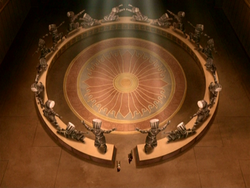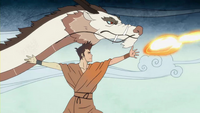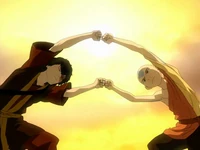| "Don't you see? These aren't dance moves. These statues are giving us a lesson. I think this is some kind of Sun Warrior firebending form." |
| — Aang to Zuko.[1] |

Statues depict the Dancing Dragon in the Sun Warriors' ancient city.
The Dancing Dragon is a traditional firebending form practiced by the Sun Warriors, who learned it from the original firebenders, the dragons, in the era of Raava.[1][2] Zuko and Aang later learned this technique while on a journey to the ancient Sun Warrior ruins in order to find a way to master firebending.
History

Wan learned the Dancing Dragon movements directly from a dragon.
During his banishment in the Spirit Wilds, Avatar Wan became the first practitioner of the Dancing Dragon, developing the technique by copying the movements of a white dragon that lived there. He later used this technique to protect the forest from hunters, his fluid style of bending proving too much for them to overcome.[2]
In 100 AG, Zuko and Aang traveled to the ruins of the ancient Sun Warrior civilization, as the young prince's firebending had weakened due to the loss of his original motivation and former rampant rage. Aang and Zuko learned the Dancing Dragon technique by imitating a series of statues they discovered in a locked room within the seemingly abandoned city; the statues demonstrated the Dancing Dragon just as it was practiced in the era before the Avatar.
After being discovered by the Sun Warriors, Aang and Zuko performed the movements when their worthiness to learn firebending was being judged by the dragons Ran and Shaw; Aang referred to this as "dancing with the dragons". After their performance, Ran and Shaw deemed Aang and Zuko worthy to understand the true meaning of firebending.[1]
When Zuko incorporated the Dancing Dragon into his fighting style, it greatly improved his skills, to the point where he was able to duel his sister, who was considered a firebending prodigy, on even terms.[3][4]
Consistency

When performed by two people at the same time, the final move of the Dancing Dragon creates an arch between them.
The Dancing Dragon is based on three types of attacks: low kicks, high punches or hits, and double punches with both fists. The Dancing Dragon has a similar appearance to Northern Shaolin Kung-Fu: it is fierce, quick, and very strong.
Trivia
- The tenth and final move of the Dancing Dragon is similar to the end of the "Fusion Dance" move in Dragon Ball Z.
- Real world "dancing dragons" are a colorful staple of traditional Chinese festivals.
References
- ↑ 1.0 1.1 1.2 O'Bryan, John (writer) & Volpe, Giancarlo (director). (July 15, 2008). "The Firebending Masters". Avatar: The Last Airbender. Season 3. Episode 13. Nickelodeon.
- ↑ 2.0 2.1 DiMartino, Michael Dante (writer) & Heck, Colin (director). (October 18, 2013). "Beginnings, Part 1". The Legend of Korra. Book Two: Spirits. Episode 7. Nickelodeon.
- ↑ Hamilton, Joshua (writer) & Spaulding, Ethan (director). (July 16, 2008). "The Boiling Rock, Part 2". Avatar: The Last Airbender. Season 3. Episode 15. Nickelodeon.
- ↑ DiMartino, Michael Dante, Konietzko, Bryan (writers) & Dos Santos, Joaquim (director). (July 19, 2008). "Sozin's Comet, Part 3: Into the Inferno". Avatar: The Last Airbender. Season 3. Episode 20. Nickelodeon.